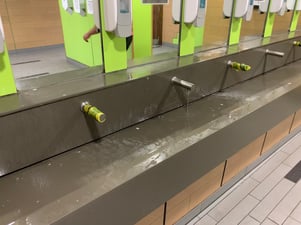How social distancing can increase the risk of Legionella - 'Sinks & toilets out of order'
We currently live in a world where the term ‘Social distancing’ is widely understood and in most cases is followed to prevent the likelihood of cross infection, specifically Covid-19. But what unintended consequence does this have on the risks of legionella, and other waterborne bacteria, multiplying and causing other health problems?
In today’s blog we go back to fundamentals for ensuring that water systems are being controlled, and discuss what mitigating steps we can take until we return to ‘normal’.
The most common way of controlling the risk from bacteria in the water system relies on some very basic principles:
- Systems designed to provide water for washing and drinking without unnecessary storage or aerosol generation and using only approved materials ;
- Ensure all outlets are used on a regular basis (the definition differs depending on the setting) so that the systems are kept moving and not allowed to stagnate;
- Keep the hot water hot;
- Keep the cold water cold.
So, if we now think about the current situation we find ourselves in, what changes have had to be made?
Businesses are closed and more employees are working from home, this will have led to a significant decrease in the amount of usage of a great number of water outlets in an array of settings . This lack of use will give bacteria additional time to multiply with the biofilm that coats the inside of pipework and other pieces of plant and equipment. Under normal usage the scouring effect of the water passing through the pipework may have helped to control the amount of biofilm present, it will also have brought low levels of chlorine [or other biocides] which can help to kill any bacteria they come in contact with over time. Additionally there will have been an increase in the amount of thermal gain likely within the cold water pipework which could have led to bacteria starting to grow, the typical daily usage would have allowed fresh cold water to keep this bacterial growth to a minimum as the lower temperature may have kept some bacteria dormant. Conversely there is also the lack of hot water going through the pipework to kill the bacteria!
But what can we do to change this?
Firstly we should ensure that any water systems that aren’t going to be used should be fully drained down. Where older pipework is found throughout the water system then draining down the systems may bring with it other issues if seals dry out and leaks occur when the systems are re-pressurised. There was some useful guidance published earlier in the year related to how we should recommission our water systems ready for them to be reoccupied. This is not an overnight process, so whilst the buildings are empty a suitable plan should be drawn up which details each step and will allow clear communication of when people can use the systems again once the restrictions are lifted.
Where systems are still in use but fewer people are in the building, then we should consider an enhanced Legionella flushing regime. In a non-healthcare setting there is a requirement to carry out flushing at least once per week until all water has been replaced (this approach is more appropriate than the previous incarnation which asked for flushing to take place for a fixed 2 minute period. There will be occasions where this time period is perfectly appropriate but in other cases it can take much longer). In a health care setting it is at least twice per week. However, if we aren’t using the building the way they were designed to be used is this enough? Should we consider moving to daily flushing to replicate daily usage?
 Next we need to consider the measures we have put in place to promote social distancing. In most places we had to restrict the number of people in a specific area and this has led to some water outlets being marked as unavailable for use (wash hand basins in public toilets for instance). Similar to buildings being underutilised, care should be taken to ensure that all of these outlets are also regularly flushed to ensure we leave no areas of stagnation. This is especially important where we have showers or spray outlets present as if these aren’t included in your flushing regime then the risk is significantly higher for the person who first uses these outlets.
Next we need to consider the measures we have put in place to promote social distancing. In most places we had to restrict the number of people in a specific area and this has led to some water outlets being marked as unavailable for use (wash hand basins in public toilets for instance). Similar to buildings being underutilised, care should be taken to ensure that all of these outlets are also regularly flushed to ensure we leave no areas of stagnation. This is especially important where we have showers or spray outlets present as if these aren’t included in your flushing regime then the risk is significantly higher for the person who first uses these outlets.
Lastly if we consider the move to using touch free taps and outlets, the obvious reduction in cross contamination risks cannot be discounted but from a water perspective we should consider the length of time the outlets are run on each activation and the number of times they are used per day. This way we will know if we are turning over enough water and getting both hot and cold water through at the temperature that will help prevent the growth of bacteria. We should also consider the internal components of these types of units to ensure we carry out the correct maintenance to keep them clean and operating as designed.
Feel free to reach out if you have any questions about this blog or if you would like to consult with one of our experts for further advice on water hygiene.
Editor’s Note: The information provided in this blog is correct at date of original publication – November 2020.
© Water Hygiene Centre 2020









